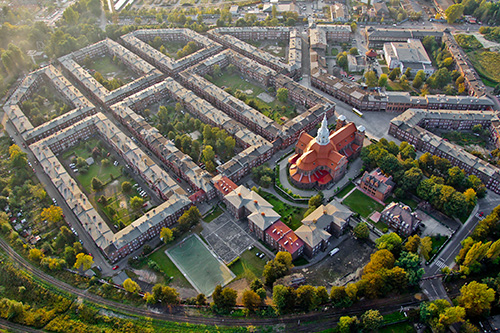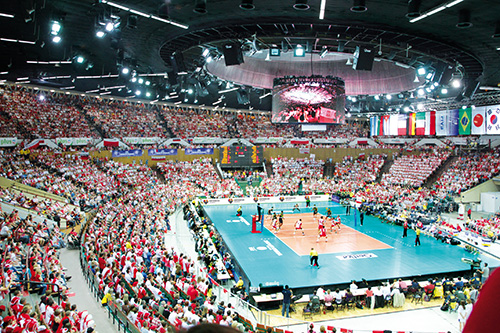Katowice is a city in Silesia, located in southwest of Poland on the Kłodnica and Rawa rivers (tributaries of the Oder and the Vistula respectively). It is in the Silesian Highlands, about 50 km north of the Silesian Beskids (part of the Carpathian Mountains) and about 100 km southeast of the Sudetes Mountains. Katowice is a capital of the Silesia region
City borders with: Chorzów, Siemianowice Śląskie, Czeladź, Sosnowiec, Mysłowice, Lędziny, Tychy, Mikołów i Ruda Śląska.
Foudation: 16th century
Population: 298 556
Area: 164,64 km2
Civic rights: 1865Y
Voivodeship: Silesian
Katowice- the city, which has completely changed its face within last few years. In the past the capital of Silesian County was associated with heavy industry, today Katowice is an European city referring to tradition. Nowadays Katowice’s face is a result of consequence of self-government body activities for the last years aiming at emphasizing its perfect location, and also economic, administrative and intellectual potential.
The city’s promotional motto is “Katowice. Dla Odmiany” (Katowice - for change). Its logo is a heart in which the traditional, industrial, mining and Silesian Katowice blends with the aspiring, economically sound, creative, ambitious, modern and avant-garde Katowice and which draws on these two complementary images.
Katowice. For a Change draws attention to the current transformation process which the capital of the Silesian province, together with the entire region, is undergoing. These changes cannot be compared to those of any other municipal area in Poland. They are manifested especially in the economy, where traditional branches are being replaced with new fields, where innovation and highly developed technologies are put to the fore and where there is a significant shift from the industrial zone to modern services, e.g. in IT.
Katowice. For a Change is also an expression of strong conviction that Katowice, with its avant-garde and innovative face, is a city worth discovering. It is a place in which new music (OFF Festival Katowice, Tauron Nowa Muzyka) coexists with avant-garde art forms (Katowice Street Art Festival, the so-called Silesian design) and bold architectural solutions (on the one hand Spodek Arena and the new home of the Silesian Museum built underground on the site of a former coal mine, and on the other hand the new seat of the Polish National Radio Symphony Orchestra - NOSPR).
Katowice. For a Change is a city of an inspiring “crash”, a merger of history with the present, tradition with modernity, proudly alluding to its industrial and Silesian identity.
Website: www.spodek.eu
More info about Katowice

History
Silesia Metropolis – a formal union of neighboring cities located within the Katowice conurbation. One of the largest and most dynamically developing metropolises in Poland and East-Central Europe.
Katowice is a unique city, the center of the largest metropolitan area in Poland and the administrative, academic and cultural heart of the Silesian Province. The city’s roots are related in the mining and metallurgy industry, while currently it is developing as a thriving economic, educational, cultural and entertainment center.
The first written note about Katowice comes from 1598 but the history of districts such as Dąb or Bogucice dates back even further. The 19th century saw the development of the area: the first two mines were opened in the 1820s and in 1865 Katowice was granted municipal rights. Soon, numerous tenements and public utilities started to spring up and the young city became the leading center for Upper Silesian industry. The events which took place after World War I – the plebiscite and the three Silesian Uprisings in 1919, 1920 and 1921 – provided the next stimulus for its growth. As a result, the eastern part of Upper Silesia together with Katowice found itself within the borders of the reborn Polish state. Katowice became the capital of the autonomous Silesian Province and several representative public administration buildings and impressive residential districts were erected in the city. Many buildings from that period are of the highest architectural quality. This tradition continued after World War II. Among many of the investments made on a grand scale, especially one – the Spodek Indoor Sports and Entertainment Arena – is widely recognized domestically as well as abroad, thanks to its unique architecture. After thorough modernization, Spodek fascinates passers-by with a multicolor illumination that stresses its characteristic architectural structure.
Today, the face of Katowice is changing. It’s impossible not to notice the growing number of modern office buildings and beautifully renovated facades of historic tenements. The city owes its new image to activities which have been consequently under- taken over the last years, using its perfect location as well as its economic, administrative and intellectual potential.
SPODEK ARENA

Construction of the “Spodek” Arena was completed in 1971. The arena was the largest and the state-of-the-art facility in Poland at that time. It has still been the most recognisable building in the capital of Silesia. Uniquely shaped components of the “Spodek” Arena form a compatible complex which covers almost a 7 ha area. Multifunctional and universal features of the elements enable to organise various events at the same time i.e.: the artistic and sporting events, fairs, exhibitions as well as congresses and trainings.
The arena has been modernised several times. The last modernisation took place in 2011. Nowadays, it is the only fully air conditioned facility in Poland.
All repairs cost PLN 70 million. As a result the facility took on a modern image. The most impressive is a new rounded LED screen, suspended from the roof. In addition, the main hall is equipped with a strong lighting and a new monitoring connected to the fire-fighting system. Currently, the “Spodek” Arena can hold up to 11,000 people.
Over the last 40 years it hosted among others: concerts, sport events, shows on ice, opera and circus performances as well as fairs, exhibitions and meetings with politicians. The most important events involve concerts of world-famous stars such as: Tina Turner, Metallica or Depeche Mode as well as matches and performances of the best sport teams of hockey, volleyball, handball players and acrobats.
The “Spodek” Arena comprises of the following components:
Main hall with the capacity of 11,000 seats
Gym with the capacity of 400 seats
Ice rink – opened all-year-round excluding a summer renovation break
Indoor swimming pool with two saunas and other water attractions
The “Spodek” Arena in numbers:
Date of construction: 1971
Date of the last renovation: 2011
Max. capacity: 11,000 seats
Gate for the disabled: gate 7
Total capacity: 338,732 m2
Usable area: 29,473 m2
Safety in the “Spodek” Arena facilities
The arena safety system allows to organise artistic and sporting events in a safe way. The building makes it possible to leave the hall in less than 10 minutes. The visual monitoring system effectively supports the audience safety.
Moreover, within the technical safety systems there operate: fire alarm system, smoke control system, drencher system, Fire hydrant installation.
The fire alarm system automatically sending signals to the fire department allows the fire brigade to arrive on the spot in about 5 minutes.